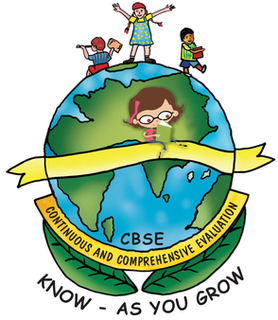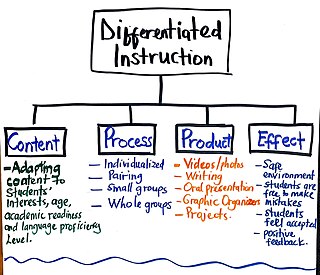
A standardized test is a test that is administered and scored in a consistent, or "standard", manner. Standardized tests are designed in such a way that the questions, conditions for administering, scoring procedures, and interpretations are consistent and are administered and scored in a predetermined, standard manner.
An electronic portfolio is a collection of electronic evidence assembled and managed by a user, usually on the Web. Such electronic evidence may include input text, electronic files, images, multimedia, blog entries, and hyperlinks. E-portfolios are both demonstrations of the user's abilities and platforms for self-expression. If they are online, users can maintain them dynamically over time.

Student-centered learning, also known as learner-centered education, broadly encompasses methods of teaching that shift the focus of instruction from the teacher to the student. In original usage, student-centered learning aims to develop learner autonomy and independence by putting responsibility for the learning path in the hands of students by imparting to them skills, and the basis on how to learn a specific subject and schemata required to measure up to the specific performance requirement. Student-centered instruction focuses on skills and practices that enable lifelong learning and independent problem-solving. Student-centered learning theory and practice are based on the constructivist learning theory that emphasizes the learner's critical role in constructing meaning from new information and prior experience.
Educational assessment or educational evaluation is the systematic process of documenting and using empirical data on the knowledge, skill, attitudes, and beliefs to refine programs and improve student learning. Assessment data can be obtained from directly examining student work to assess the achievement of learning outcomes or can be based on data from which one can make inferences about learning. Assessment is often used interchangeably with test, but not limited to tests. Assessment can focus on the individual learner, the learning community, a course, an academic program, the institution, or the educational system as a whole. The word 'assessment' came into use in an educational context after the Second World War.
Electronic assessment, also known as digital assessment, e-assessment, online assessment or computer-based assessment, is the use of information technology in assessment such as educational assessment, health assessment, psychiatric assessment, and psychological assessment. This covers a wide range of activity ranging from the use of a word processor for assignments to on-screen testing. Specific types of e-assessment include multiple choice, online/electronic submission, computerized adaptive testing such as the Frankfurt Adaptive Concentration Test, and computerized classification testing.
In US education terminology, rubric is "a scoring guide used to evaluate the quality of students' constructed responses". Put simply, it is a set of criteria for grading assignments. Rubrics usually contain evaluative criteria, quality definitions for those criteria at particular levels of achievement, and a scoring strategy. They are often presented in table format and can be used by teachers when marking, and by students when planning their work.
Recognition of prior learning (RPL), prior learning assessment (PLA), or prior learning assessment and recognition (PLAR), describes a process used by regulatory bodies, adult learning centres, career development practitioners, military organizations, human resources professionals, employers, training institutions, colleges and universities around the world to evaluate skills and knowledge acquired outside the classroom for the purpose of recognizing competence against a given set of standards, competencies, or learning outcomes. RPL is practiced in many countries for a variety of purposes, for example an individual's standing in a profession, trades qualifications, academic achievement, recruitment, performance management, career and succession planning.
In an educational setting, standards-based assessment is assessment that relies on the evaluation of student understanding with respect to agreed-upon standards, also known as "outcomes". The standards set the criteria for the successful demonstration of the understanding of a concept or skill.
A course evaluation is a paper or electronic questionnaire, which requires a written or selected response answer to a series of questions in order to evaluate the instruction of a given course. The term may also refer to the completed survey form or a summary of responses to questionnaires.
Summative assessment, summative evaluation, or assessment of learning is the assessment of participants where the focus is on the outcome of a program. This contrasts with formative assessment, which summarizes the participants' development at a particular time. Summative assessment is widely taught in educational programs in the United States. Michael Scriven claims that while all assessment techniques can be summative, only some are formative.
Formative assessment, formative evaluation, formative feedback, or assessment for learning, including diagnostic testing, is a range of formal and informal assessment procedures conducted by teachers during the learning process in order to modify teaching and learning activities to improve student attainment. The goal of a formative assessment is to monitor student learning to provide ongoing feedback that can help students identify their strengths and weaknesses and target areas that need work. It also helps faculty recognize where students are struggling and address problems immediately. It typically involves qualitative feedback for both student and teacher that focuses on the details of content and performance. It is commonly contrasted with summative assessment, which seeks to monitor educational outcomes, often for purposes of external accountability.
Authentic assessment is the measurement of "intellectual accomplishments that are worthwhile, significant, and meaningful," as contrasted with multiple-choice tests. Authentic assessment can be devised by the teacher, or in collaboration with the student by engaging student voice. When applying authentic assessment to student learning and achievement, a teacher applies criteria related to “construction of knowledge, disciplined inquiry, and the value of achievement beyond the school.”
Assessment in computer-supported collaborative learning (CSCL) environments is a subject of interest to educators and researchers. The assessment tools utilized in computer-supported collaborative learning settings are used to measure groups' knowledge learning processes, the quality of groups' products and individuals' collaborative learning skills.

Continuous and Comprehensive Evaluation (CCE) was a process of assessment, mandated by the Right to Education Act, of India in 2009. This approach to assessment was introduced by state governments in India, as well as by the Central Board of Secondary Education in India, for students of sixth to tenth grades and twelfth in some schools. From this the smaller classes student would have a practice to face the exam of board in younger age. The Karnataka government introduced CCE for grades 1 through 9 later it was also introduced for 12th grades students. The main aim of CCE was to evaluate every aspect of the child during their presence at the school. This was believed to help reduce the pressure on the child during/before examinations as the student will have to sit for multiple tests throughout the year, of which no test or the syllabus covered will be repeated at the end of the year, whatsoever. The CCE method was claimed to bring enormous changes from the traditional chalk and talk method of teaching, provided it is implemented accurately.

Differentiated instruction and assessment, also known as differentiated learning or, in education, simply, differentiation, is a framework or philosophy for effective teaching that involves providing all students within their diverse classroom community of learners a range of different avenues for understanding new information in terms of: acquiring content; processing, constructing, or making sense of ideas; and developing teaching materials and assessment measures so that all students within a classroom can learn effectively, regardless of differences in their ability. Differentiated instruction, according to Carol Ann Tomlinson, is the process of "ensuring that what a student learns, how he or she learns it, and how the student demonstrates what he or she has learned is a match for that student's readiness level, interests, and preferred mode of learning." According to Boelens et al. (2018), differentiation can be on two different levels: the administration level and the classroom level. The administration level takes the socioeconomic status and gender of students into consideration. At the classroom level, differentiation revolves around content, processing, product, and effects. On the content level, teachers adapt what they are teaching to meet the needs of students. This can mean making content more challenging or simplified for students based on their levels. The process of learning can be differentiated as well. Teachers may choose to teach individually at a time, assign problems to small groups, partners or the whole group depending on the needs of the students. By differentiating product, teachers decide how students will present what they have learnt. This may take the form of videos, graphic organizers, photo presentations, writing, and oral presentations. All these take place in a safe classroom environment where students feel respected and valued—effects.
Continuous assessment is a form of educational examination that evaluates a student's progress throughout a prescribed course. It is often used as an alternative to the final examination system. Proponents of continuous assessment argue that the approach allows tracking of progress and has a chance of offering students more support, guidance, and opportunities to improve during the course or programme.
Writing assessment refers to an area of study that contains theories and practices that guide the evaluation of a writer's performance or potential through a writing task. Writing assessment can be considered a combination of scholarship from composition studies and measurement theory within educational assessment. Writing assessment can also refer to the technologies and practices used to evaluate student writing and learning.
Data based decision making or data driven decision making refers to educator’s ongoing process of collecting and analyzing different types of data, including demographic, student achievement test, satisfaction, process data to guide decisions towards improvement of educational process. DDDM becomes more important in education since federal and state test-based accountability policies. No Child Left Behind Act opens broader opportunities and incentives in using data by educational organizations by requiring schools and districts to analyze additional components of data, as well as pressing them to increase student test scores. Information makes schools accountable for year by year improvement various student groups. DDDM helps to recognize the problem and who is affected by the problem; therefore, DDDM can find a solution of the problem
Data-driven instruction is an educational approach that relies on information to inform teaching and learning. The idea refers to a method teachers use to improve instruction by looking at the information they have about their students. It takes place within the classroom, compared to data-driven decision making. Data-driven instruction works on two levels. One, it provides teachers the ability to be more responsive to students’ needs, and two, it allows students to be in charge of their own learning. Data-driven instruction can be understood through examination of its history, how it is used in the classroom, its attributes, and examples from teachers using this process.
Randy Elliot Bennett is an American educational researcher who specializes in educational assessment. He is currently the Norman O. Frederiksen Chair in Assessment Innovation at Educational Testing Service in Princeton, NJ. His research and writing focus on bringing together advances in cognitive science, technology, and measurement to improve teaching and learning. He received the ETS Senior Scientist Award in 1996, the ETS Career Achievement Award in 2005, the Teachers College, Columbia University Distinguished Alumni Award in 2016, Fellow status in the American Educational Research Association (AERA) in 2017, the National Council on Measurement in Education's (NCME) Bradley Hanson Award for Contributions to Educational Measurement in 2019, the E. F. Lindquist Award from AERA and ACT in 2020, and elected membership in the National Academy of Education in 2022. Randy Bennett was elected President of both the International Association for Educational Assessment (IAEA), a worldwide organization primarily constituted of governmental and NGO measurement organizations, and the National Council on Measurement in Education (NCME), whose members are employed in universities, testing organizations, state and federal education departments, and school districts.



